
The Gupta Empire (c. 320–550 CE): India's Golden Age of Culture, Science, and Prosperity
Explore the Gupta Empire (320-550 CE), India's Golden Age of unprecedented cultural, scientific, and economic achievements. Discover how this remarkable civilization established foundations in mathematics, literature, art, and governance that continue influencing modern society. Learn about key rulers like Chandragupta II, revolutionary innovations including the concept of zero, architectural masterpieces, and the empire's lasting global legacy through comprehensive historical analysis.
INDIAN HISTORYEMPIRES/HISTORYHISTORY
Keshav Jha
8/19/20259 min read
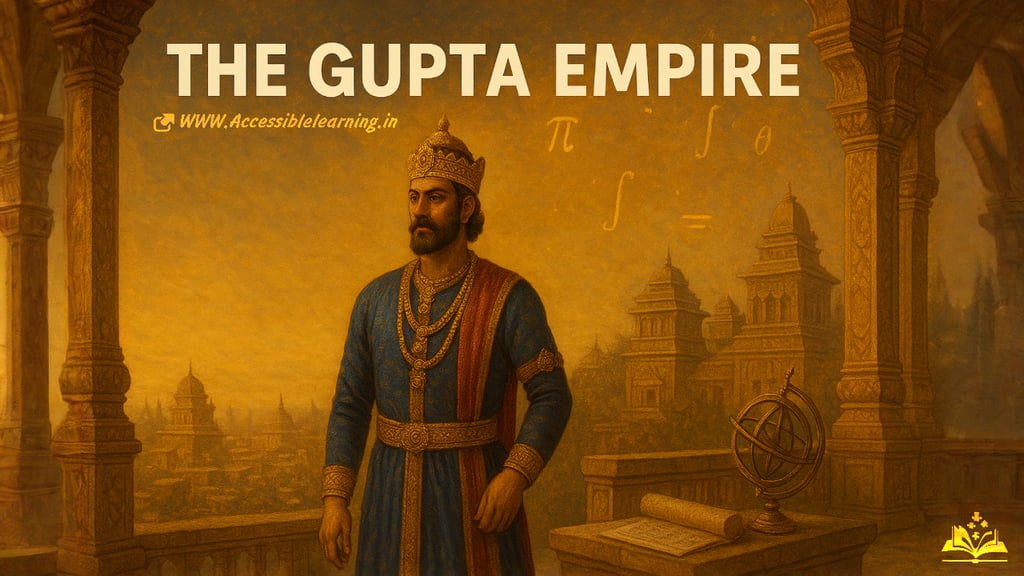

The Gupta Empire, spanning approximately from 320 to 550 CE, represents one of ancient India's most remarkable periods of cultural, scientific, and economic flourishing. Often referred to as the "Golden Age of India," this empire established foundations that would influence Indian civilization for centuries. The Gupta period witnessed unprecedented achievements in mathematics, astronomy, literature, art, and governance that continue to shape modern understanding of classical Indian culture.
This comprehensive examination explores the dynasty's rise, territorial expansion, administrative innovations, cultural contributions, and lasting legacy within the broader context of ancient Indian history.
Origins and Foundation of Gupta Rule
Early Beginnings Under Chandragupta I
The Gupta dynasty emerged in the early fourth century CE when Chandragupta I established the foundation of what would become a powerful empire. Unlike his more famous Mauryan predecessor of the same name, this Chandragupta began his reign around 320 CE in the Magadha region of present-day Bihar. His strategic marriage to Kumaradevi, a princess from the influential Licchavi clan, significantly strengthened his political position and provided crucial alliances for future expansion.
The empire's initial territory encompassed the fertile Ganges valley, providing the economic foundation necessary for sustained growth. Chandragupta I's adoption of the title "Maharajadhiraja" (king of kings) signaled his ambitions beyond regional rule, establishing the precedent for imperial expansion that his successors would fulfill.
Samudragupta's Military Campaigns and Territorial Expansion
Samudragupta, who ruled from approximately 335 to 375 CE, transformed his father's modest kingdom into a vast empire through systematic military campaigns. Historical records, particularly the famous Allahabad Pillar inscription composed by court poet Harishena, document his extensive conquests across northern and central India.
His military strategy combined direct annexation of strategically important territories with the establishment of tributary relationships with distant kingdoms. This approach allowed the Gupta Empire to exert influence across a vast geographical area while maintaining administrative efficiency. Samudragupta's campaigns extended Gupta authority from the Himalayas in the north to the Narmada River in the south, creating the territorial foundation for the empire's golden age.
Peak Period Under Chandragupta II Vikramaditya
Administrative Excellence and Governance
Chandragupta II, ruling from approximately 375 to 415 CE, presided over the Gupta Empire's zenith. His reign, lasting nearly four decades, established administrative systems that balanced central authority with local autonomy. The empire's governance structure featured a sophisticated hierarchy of officials, from provincial governors to local administrators, ensuring effective control over vast territories while accommodating regional variations in culture and custom.
The Gupta administrative system emphasized meritocracy in bureaucratic appointments, promoting capable individuals regardless of their social background. This approach fostered loyalty among administrators and contributed to the empire's stability during its peak years. Revenue collection systems combined land taxes with trade duties, creating a diversified economic base that funded extensive public works and cultural patronage.
Economic Prosperity and Trade Networks
The Gupta period witnessed remarkable economic expansion, driven by agricultural productivity, manufacturing excellence, and extensive trade networks. The empire's location along major trade routes connecting Central Asia, China, and Southeast Asia with the Mediterranean world positioned it advantageously for commercial growth.
Gupta craftsmen achieved international recognition for their metalwork, particularly in iron and steel production. The famous Delhi Iron Pillar, erected during this period, demonstrates the advanced metallurgical knowledge of Gupta artisans. Textile production, especially fine cotton and silk fabrics, became another major export industry, with Gupta textiles reaching markets from Rome to Southeast Asia.
The empire's monetary system, featuring gold coins of exceptional purity and artistic merit, facilitated both domestic and international commerce. These coins, often bearing portraits of rulers and religious symbols, serve as important historical documents revealing the empire's economic sophistication and cultural values.
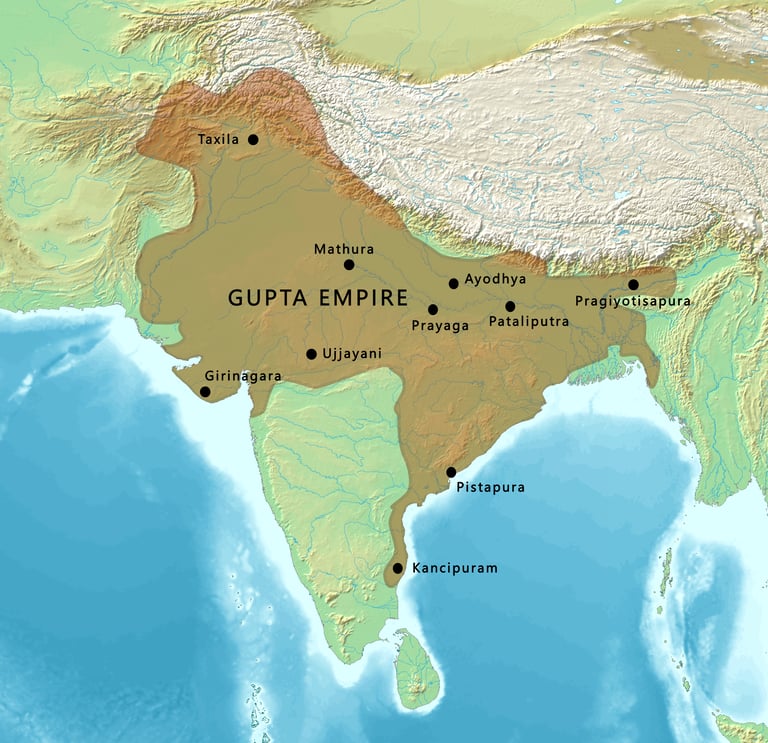

Cultural and Intellectual Achievements
Literary Renaissance and Sanskrit Literature
The Gupta period marked the culmination of classical Sanskrit literature, with court patronage enabling poets and dramatists to create enduring masterpieces. Kalidasa, often considered the greatest Sanskrit poet, flourished during this era, producing works such as "Shakuntala," "Meghaduta," and "Raghuvamsha" that remain influential in world literature.
The period also witnessed the compilation and refinement of major Hindu texts, including the final versions of the Puranas and important commentaries on Vedic literature. This literary activity reflected broader cultural confidence and the synthesis of various intellectual traditions within the empire's cosmopolitan environment.
Educational institutions, particularly those associated with Buddhist monasteries and Hindu temples, flourished under Gupta patronage. The university at Nalanda, though reaching its peak slightly later, began its development during this period, establishing patterns of higher learning that would influence education across Asia.
Scientific and Mathematical Innovations
Gupta scholars made groundbreaking contributions to mathematics, astronomy, and other sciences that influenced global intellectual development. Aryabhata, the renowned mathematician and astronomer, produced revolutionary works during this period, including accurate calculations of pi, explanations of lunar eclipses, and propositions about the Earth's rotation.
The concept of zero as both a placeholder and a number, fundamental to modern mathematics, received its definitive formulation during the Gupta period. This mathematical innovation, along with the decimal place-value system, would eventually transform calculations worldwide after transmission to the Islamic world and subsequently to Europe.
Gupta astronomers created sophisticated mathematical models for predicting celestial events, compiled accurate calendars, and established observational methods that influenced subsequent astronomical traditions. Their work demonstrated the integration of theoretical knowledge with practical applications, characteristic of Gupta intellectual culture.
Architectural and Artistic Achievements
Gupta architecture established classical Indian architectural principles that would influence temple design for centuries. The period witnessed the evolution from earlier rock-cut architecture to free-standing stone temples, with examples like the Dashavatara Temple at Deogarh showcasing the emerging classical style.
Sculpture during the Gupta period achieved a distinctive style characterized by refined proportions, graceful poses, and spiritual expression. The Buddha images from Sarnath and Mathura exemplify the Gupta sculptural ideal, combining physical perfection with spiritual serenity in ways that influenced Buddhist art across Asia.
Cave paintings at Ajanta, particularly those from the later Gupta period, represent the pinnacle of ancient Indian painting. These works demonstrate sophisticated techniques in composition, color usage, and narrative illustration that reveal the period's artistic sophistication and cultural values.
Religious Developments and Tolerance
Hindu Renaissance and Temple Culture
The Gupta period witnessed a significant revival and systematization of Hindu religious practices, often termed the Hindu Renaissance. While the dynasty maintained official patronage of Hinduism, particularly Vaishnavism, they demonstrated remarkable religious tolerance that allowed diverse traditions to flourish simultaneously.
Temple construction accelerated during this period, establishing architectural and ritual patterns that would define Hindu temple culture. The development of Puranic literature during Gupta rule provided accessible religious narratives that helped popularize Hindu devotional practices among broader populations.
The period also saw the codification of Hindu law through texts like the Dharmashastra literature, which attempted to systematize religious, social, and legal practices. These compilations reflected efforts to create coherent cultural frameworks while accommodating regional variations and changing social conditions.
Buddhist and Jain Communities
Despite the Hindu revival, Buddhist communities continued to thrive under Gupta rule, particularly in monastic centers and educational institutions. The Chinese pilgrim Faxian, who visited India during Chandragupta II's reign, reported flourishing Buddhist communities and impressive monastic establishments throughout the empire.
Jain communities also maintained their traditions and contributed to the period's intellectual life. The religious diversity of the Gupta Empire created an environment of intellectual exchange that enriched all traditions and contributed to the period's remarkable cultural achievements.
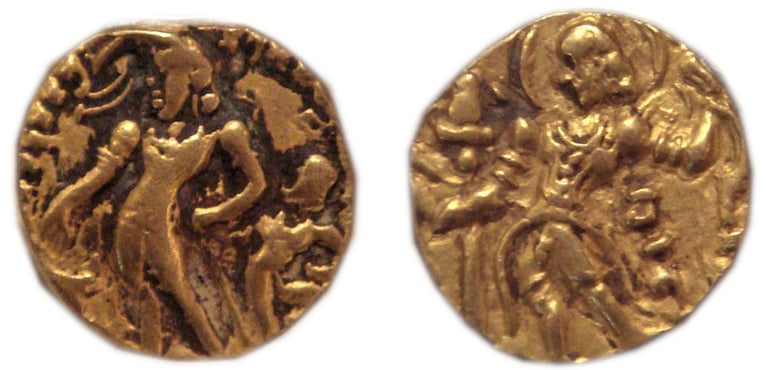


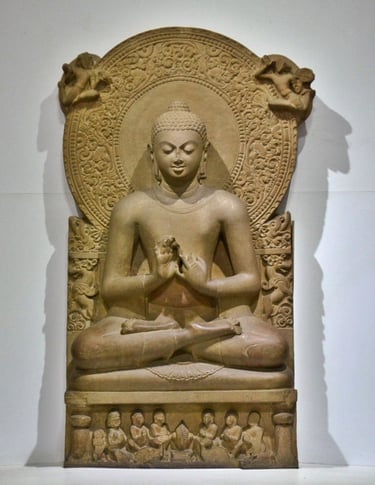
Decline and Fragmentation
Huna Invasions and External Pressures
The Gupta Empire's decline began in the late fifth century CE due to multiple factors, with invasions by the Huna peoples representing the most immediate threat. These Central Asian nomadic groups, led by rulers like Toramana and Mihirakula, disrupted the empire's northwestern territories and challenged Gupta military capabilities.
The invasions strained imperial resources and exposed weaknesses in the empire's defensive strategies. While Gupta forces achieved some victories against the invaders, the prolonged conflicts weakened central authority and encouraged regional autonomy movements.
Internal Challenges and Succession Disputes
Simultaneously, internal problems undermined imperial cohesion. Succession disputes following the death of strong rulers created opportunities for provincial governors to assert independence. The empire's decentralized administrative system, while effective during periods of strong central leadership, became a liability when imperial authority weakened.
Economic pressures, including the costs of prolonged military campaigns and reduced trade revenues due to external threats, further compromised the empire's stability. The combination of external invasions and internal centrifugal forces eventually proved insurmountable for the imperial structure.
Legacy & Historical Impact
Influence on Subsequent Indian Civilization
The Gupta Empire's cultural and intellectual achievements established foundations that influenced Indian civilization long after the dynasty's political demise. The classical Sanskrit literature, architectural styles, scientific methodologies, and administrative practices developed during this period provided templates for later Indian kingdoms and cultural movements.
The Gupta model of governance, combining strong central authority with local autonomy and religious tolerance, influenced subsequent Indian political thought and practice. Many later dynasties attempted to recreate the prosperity and cultural flourishing associated with Gupta rule.
Global Contributions and Recognition
International recognition of Gupta achievements continues to grow as scholars better understand the period's global significance. The mathematical and astronomical innovations of Gupta scholars contributed fundamentally to worldwide intellectual development, while artistic and literary achievements influenced cultural traditions across Asia.
Modern archaeological discoveries continue to reveal the sophistication of Gupta urban planning, manufacturing techniques, and trade networks, demonstrating the empire's role in ancient global commerce and cultural exchange.
The Gupta Empire's remarkable achievements in governance, culture, science, and arts established it as one of history's most influential civilizations. The dynasty's success in creating conditions for intellectual and artistic flourishing while maintaining political stability and economic prosperity provides valuable insights into the factors that enable civilizational peak periods.
The empire's legacy extends far beyond its chronological boundaries, with contributions to mathematics, literature, art, and political thought continuing to influence global civilization. The Gupta model of combining strong governance with cultural tolerance and intellectual freedom remains relevant for understanding how societies can achieve sustained prosperity and cultural achievement.
Contemporary scholars increasingly recognize the Gupta period's global significance, moving beyond regional historical perspectives to acknowledge its contributions to world civilization. This recognition reflects growing understanding of the interconnected nature of ancient civilizations and the Gupta Empire's role in facilitating cultural and intellectual exchange across Asia.
The study of Gupta civilization offers valuable perspectives on leadership, cultural development, scientific innovation, and the complex factors that contribute to civilizational achievement. These insights remain relevant for contemporary societies seeking to balance progress with tradition, diversity with unity, and material prosperity with cultural flourishing.

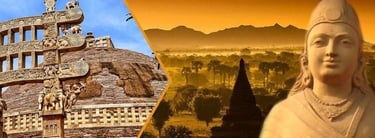
Frequently Asked Questions
Q: What made the Gupta Empire the "Golden Age" of India?
The Gupta Empire earned recognition as India's "Golden Age" due to unprecedented achievements in literature, science, mathematics, art, and governance. The period witnessed the creation of classical Sanskrit literature by poets like Kalidasa, revolutionary mathematical concepts including the formalization of zero, architectural masterpieces, and sophisticated administrative systems that balanced central authority with local autonomy.
Q: How did the Gupta Empire maintain control over such a vast territory?
The Gupta Empire employed a sophisticated administrative system that combined direct rule over core territories with tributary relationships with distant regions. Provincial governors maintained local authority while acknowledging imperial supremacy, creating a flexible structure that accommodated regional diversity while ensuring central coordination for major policies and military campaigns.
Q: What were the major scientific achievements of the Gupta period?
Gupta scholars made groundbreaking contributions, including Aryabhata's accurate calculations of pi and explanations of lunar eclipses, the definitive formulation of zero as both placeholder and number, the development of the decimal place-value system, sophisticated astronomical models for predicting celestial events, and advanced metallurgical techniques demonstrated by monuments like the Delhi Iron Pillar.
Q: How did the Gupta Empire treat religious diversity?
The Gupta Empire demonstrated remarkable religious tolerance despite official patronage of Hinduism. Buddhist and Jain communities flourished alongside Hindu institutions, with imperial support for diverse religious establishments and educational centers. This tolerance created an environment of intellectual exchange that enriched all traditions and contributed to the period's cultural achievements.
Q: What caused the decline of the Gupta Empire?
The Gupta Empire's decline resulted from multiple factors, including invasions by Huna peoples from Central Asia, internal succession disputes, regional autonomy movements, economic pressures from prolonged military campaigns, and the inherent challenges of governing vast territories with limited communication and transportation infrastructure.
Q: How did Gupta achievements influence later civilizations?
Gupta mathematical innovations, particularly the concept of zero and decimal notation, eventually reached the Islamic world and Europe, revolutionizing global mathematics. Artistic styles influenced Buddhist art across Asia, architectural principles shaped Indian temple design for centuries, and administrative models provided templates for subsequent Indian kingdoms seeking to recreate Gupta prosperity.
Subscribe To Our Newsletter
All © Copyright reserved by Accessible-Learning Hub
| Terms & Conditions
Knowledge is power. Learn with Us. 📚


